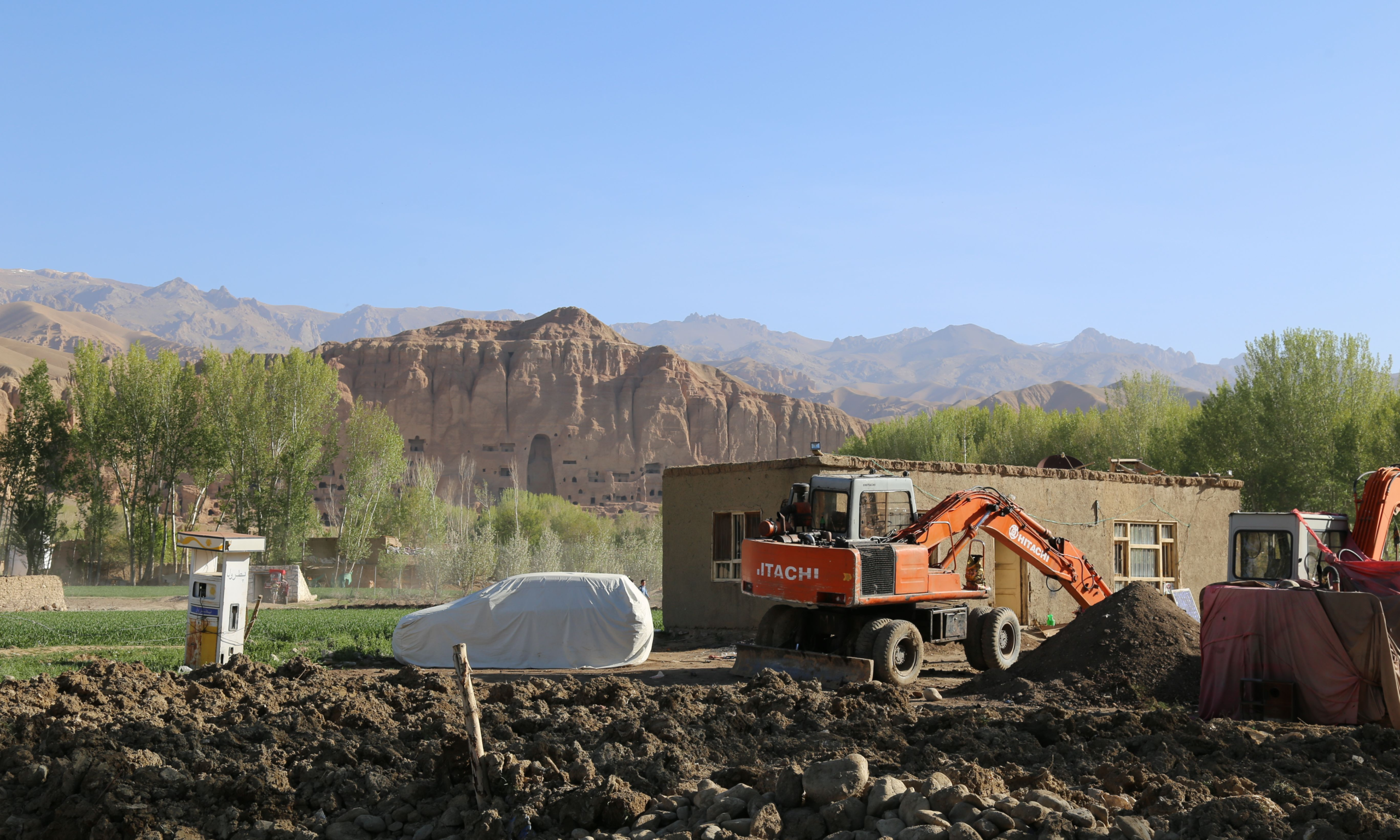Construction on Bamiyan's Unesco listed land is ongoing. Cultural activists say the Taliban will not protect the area because they do not believe in heritage.
Following heavy criticism of the damage wreaked by illegal coal and wood traders on Afghanistan’s Bamiyan Valley, the Taliban have issued a newsletter reporting that their local authorities have ordered the traders to leave the Unesco listed heritage sites. The workers have been asked to relocate within two weeks to areas designated by the municipality.
Bamiyan Valley was once home to the sixth- and seventh-century Buddha statues known as Salsal, or the Western Buddha, and Shahmama, or the Eastern Buddha. They stood in carved niches in the cliff until, in 2001, the Taliban blew them up. In 2003, the area was put on Unesco’s World Heritage in Danger list.
Wood traders and carpenters can be seen operating on Unesco listed land near the Eastern Buddha niche. The containers, heavy vehicles and temporary structures were not permitted in this area prior to the Taliban takeover. There are no signs of the traders moving despite the new Taliban order to relocate.
The Art Newspaper has previously reported that since the Taliban take over in August 2021, illegal excavations, combined with rapid unplanned developments in the area such as a large coal loading depot that had popped up in front of the Western Buddha cavity, were contributing to the complete destruction of the Bamiyan cliff and its surrounding area.
However, the news of the Taliban order was not immediately welcomed by cultural heritage experts and residents who say it is nothing but an empty promise aimed to distract people from their concerns and to score points with Unesco, who are rumoured to be planning a visit to Bamiyan in the coming weeks.
“I don’t believe they will actually go ahead and remove these traders,” Ghulam Reza Mohammadi, the former Unesco provincial coordinator for Bamiyan, tells The Art Newspaper. “The people who have to enforce this order are the ones who own the businesses or the land, so we can’t expect very much to change,” explains Mohammadi, who had to be evacuated to Germany in August to escape the Taliban for fear of persecution.
A market has developed in the valley and is expanding on Unesco listed landscape land.
A number of Bamiyan residents echo Mohammadi’s views while adding that several coal traders had already moved out at the end of winter when demand for coal fuel used for heating had naturally declined.
They also warn there is little appetite left among even the most dedicated of culture lovers to protect the sites given the brutal and deadly attacks that have rocked Afghanistan over the last week, which primarily targeted Hazaras, the majority ethnic population of Bamiyan.
A large coal depot operates in close vicinity of the Western Buddha niche with no sign of it closing down. Heavy vehicles which were prohibited from entering the valley now regularly use the area for loading and offloading.
On 19 April two deadly blasts targeted a high school in western Kabul’s Shia Hazara dominated area. Then on 21 April a number of deadly explosions took place across the country, including one at a Shia mosque in the northern city of Mazar-i-Sharif. The next day a Sunni mosque was the target of a bomb during Friday prayers. The Taliban is said to have limited what local journalists could report on the attacks.
“People are dying. Everyone is petrified about the prospect of similar attacks happening here,” says a worried Nawid, a Bamiyan resident who wishes to hide his real identity for his safety. “How can people think about or care about protecting heritage sites during times like this? When you are consumed with saving your life there is no energy left to think about anything else,” Nawid adds.
“Bamiyan is not safe in the hands of the Taliban, they have proved that over and over. It is clear that Afghanistan and its people are not safe in their hands," he warns.
Two other residents who did not wish to be identified say the Taliban has prevented some of the new constructions however, they admit there were little repercussions if people continued with their activities.
The distrust between the locals and the Taliban is deepened further by the fact that the current governor of Bamiyan, Mullah Abdullah Sarhadi, was the commander who led the destruction of the statues back in 2001.
Existing petrol pumps near the Eastern Buddha niche which were planned to be decommissioned. Instead new constructions can be seen developing around them. Residents say rather than decommissioning existing pumps the Taliban have built new petrol pumps on listed land.
“The Taliban does not understand or care about heritage, especially Bamiyan heritage which is closely linked with Hazaras,” says a local cultural activist who wishes to not share his identity for his safety. “A petrol station has now been built on listed land, this is a permanent structure and there are many such developments appearing in Bamiyan on a daily basis,” he says. The resident conceded that there were petrol pumps on listed lands prior to the Taliban’s arrival however, he says plans had been drawn up by the authorities to decommission and relocate them.
“I don’t believe the Taliban will prohibit the illegal developments," he says. "But the Unesco visits and media coverage will perhaps keep the pressure on them and slow down some of what is going on."

